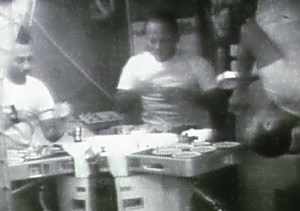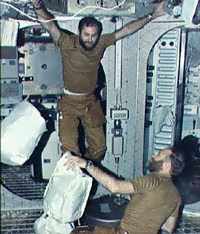|
Galley

Function:
Food Preparation
Cooking
Dining Area
Provisions Storage

Meal Time
Originally, the problem of supplying food for weightless conditions was solved by putting precooked food into tubes, which the astronaut squeezed into his mouth. Room on board was very limited and floating crumbs and droplets of liquid were something that had to be avoided at all costs. With more room on board and modern commercial food packaging, the menu has become much more varied.
There is an on-board galley (kitchen) where pre-packed meals are stored - vacuum-packed, dehydrated, canned or deep-frozen. The astronaut uses a pump to rehydrate the food, which is in a sealed plastic bag; food requiring cooking is put in an oven. When it is all prepared it is put into a food tray, similar to an airliner meal tray. The meal is sticky, or jelly-like, so that small particles do not take off and travel round the cabin. A lump floating slowly off can be captured by a hungry astronaut's mouth. Liquid, such as orange juice, will form a ball which can be sucked up using a straw.
 This image is taken from the Skylab 3 from a TV recording. It shows the crew, Alan Bean (right), Jack Lousma and Owen Garriott (left) having a meal. Weightlessness is not a natural condition for the human body. Eating is one of the most basic functions we perform. Weightlessness presents difficulties in simply getting the food onto the plate, and these need to be solved. Certain foods are more difficult to deal with than others. The food you eat is also very important in keeping you in a good mood, by giving you pleasure. Life aboard the space station is life away from Earth, and the food the astronauts eat will be an important link with Earth. This image is taken from the Skylab 3 from a TV recording. It shows the crew, Alan Bean (right), Jack Lousma and Owen Garriott (left) having a meal. Weightlessness is not a natural condition for the human body. Eating is one of the most basic functions we perform. Weightlessness presents difficulties in simply getting the food onto the plate, and these need to be solved. Certain foods are more difficult to deal with than others. The food you eat is also very important in keeping you in a good mood, by giving you pleasure. Life aboard the space station is life away from Earth, and the food the astronauts eat will be an important link with Earth.
It's not just food that floats about: your plate and knife and fork will drift away from you as well.
On long-duration shuttle missions, astronauts are allowed approximately 1.6 kgs of food per day, and approximately 11 kgs of water for drinking, washing, rehydrating food and waste disposal. Because the space station cannot afford to waste water, they will recycle it. Food inevitably produces waste - this is important for our health, but poses problems in an enclosed environment like a space station.
 Other everyday things that you need to do might include washing clothes, washing up, vacuum cleaning and occasionally wiping down panels with anti-bacteria and anti-fungal solution. Space Stations structures collect condensation and this can cause health hazard if left to breed yeasts and germs. Other everyday things that you need to do might include washing clothes, washing up, vacuum cleaning and occasionally wiping down panels with anti-bacteria and anti-fungal solution. Space Stations structures collect condensation and this can cause health hazard if left to breed yeasts and germs.
Taking out the trash (right): Skylab 4 crew move bags of waste for transport back to Earth. Typically on Mir, when a crew changed, or a Progress supply ship docked, two or more tonnes of garbage had to be manhandled from the Station to spacecraft. Just because it is weightless it doesnt mean it needs no effort to move. Astronauts report that this is one of the most energy depleting and sole-destroying tasks they have to do on any space station. But of course it must be done! There are no garbage men in space.... yet.
For an account of everyday life on a Shuttle Mission go to Space Life Science Data Kids' Page.
And for the Skylab images and information go to Skylab Archive.

Project:
Menu
As a crew member you are going to the Space Station for six months. You have been given permission to choose your menu for your stay. Assume that you use a system based on a two-week cycle, so that every third week your menu repeats itself.
What choices would you give to the mission planners?
How would you make sure it was balanced?
Remember that your bones lose calcium in microgravity. Exercise will help, but diet is also important.
Can you think of any ways of stopping your plates and cutlery drifting away?
Check out these pages for assistance Space Life Science Data Kids' Page.

Washing clothes
Should you wash your clothes on the Station or take a six month supply of new ones?
Let us suppose you need just the following items of clothing and you are allocated them the basis shown. The temperature is regulated so you should not need the sweater very often.
Clothing Allocation
|
Clothes Item
|
Allocation
|
Weight
grammes
|
Volume
cu cm
|
| Socks |
1 pair per day |
250 |
200 |
| Underwear |
1 set per day |
750 |
800 |
| Shirt/Blouse |
1 per 2 days |
700 |
2200 |
| Trousers |
1 pair per week |
850 |
4500 |
| Sweater |
1 per month |
800 |
6000 |
Calculate the weight and volume of clothing necessary for a six month's stay on the Station for the entire crew. Assume a month is 30 days.
Now calculate the cost of getting those clothes to the Space Station. It costs $1000 per kilogram (there are 1000 grammes in a kilogram, and a million cubic centimetres in a cubic metre) to get things to the Station - that is, the cost of the launch which includes the rocket or shuttle, the use of the launch pad and all the mission contol facilities.
A space washing machine in available for $1,000,000. The washing machine also dries the clothes, but it takes up one cubic metre of volume.
Should we buy it?
Take account of the storage space required for the clothes and the cost in getting them to the Space Station. The cost of the clothes themselves can be ignored, that is tiny compared with the cost of transport.
What other factors should influence your decision?
(Hint: think about Energy and Resources, Waste, Personal Preferences, Crew Time)

Go to Space Station 2020 Specification
Return to title page
 |













